利用者:ロイヤルオーク/sandbox/下書き15
The United Nations Educational, Scientific and Cultural Organization (UNESCO) World Heritage Sites are places of importance to cultural or natural heritage as described in the UNESCO World Heritage Convention, established in 1972.[1] Cultural heritage consists of monuments (such as architectural works, monumental sculptures, or inscriptions), groups of buildings, and sites (including archaeological sites). Natural features (consisting of physical and biological formations), geological and physiographical formations (including habitats of threatened species of animals and plants), and natural sites which are important from the point of view of science, conservation or natural beauty, are defined as natural heritage.[2]
The first sites on the territory of the present Czech Republic were inscribed at the 16th Session of the World Heritage Committee, held in Santa Fe, United States in 1992, when the country was part of the Czech and Slovak Federative Republic (also known as Czechoslovakia). At that session, three sites were added: Historic Centre of Prague, Historic Centre of Český Krumlov and Historic Centre of Telč.[3]
With the dissolution of Czechoslovakia on January 1, 1993, the country was split into the Czech Republic (also known as Czechia) and Slovakia. The Czech Republic officially adopted the convention on March 26, 1993, inheriting those three sites. 2021年現在[update], there are 14 sites inscribed on the list and a further 17 sites on the tentative list. All of these sites are of the cultural type and one of them, the Erzgebirge/Krušnohoří Mining Region, is shared with Germany. The most recent site added to the list was the Landscape for Breeding and Training of Ceremonial Carriage Horses at Kladruby nad Labem, in 2019.[4]
World Heritage Sites
[編集]UNESCO lists sites under ten criteria; each entry must meet at least one of the criteria. Criteria i through vi are cultural, whereas vii through x are natural.[5]
| Site | Image | Location | Year listed | UNESCO data | Description |
|---|---|---|---|---|---|
| Historic Centre of Prague | 
|
Prague | 1992 | 616bis; ii, iv, vi (cultural) | Prague, situated on the banks of the Vltava river, has been an important European city since the Middle Ages. During the reign of Charles IV, Holy Roman Emperor, several monuments were constructed in the Gothic style, including Prague Castle, St. Vitus Cathedral, and Charles Bridge. The University of Prague, one of the oldest universities in Europe, was founded in 1348, and made Prague one of the leading centres of learning. Průhonice Park, which lies outside of Prague, has been included in 2010 as a masterpiece of garden landscape architecture of worldwide importance. A minor boundary modification of the World Heritage Site took place in 2012.[6] |
| Historic Centre of Český Krumlov | 
|
South Bohemian Region | 1992 | 617; iv (cultural) | The town of Český Krumlov was built around the eponymous 13th century castle on a meander of the Vltava river. The castle was built in Gothic style, with later additions of Late Gothic, Renaissance and Baroque elements. The town preserves the street layout from the Middle Ages, while the house facades feature decorations in the Renaissance and Baroque styles. The town was not affected by the industrialisation in the 19th century.[7] |
| Historic Centre of Telč | 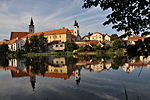
|
Vysočina Region | 1992 | 621; i, iv (cultural) | The town of Telč was likely founded in the mid-14th century as a planned settlement in an area that was previously covered by deep forests, in order to exert political and economic influence over the region. The centre of the town is dominated by a Renaissance castle that was built upon a Gothic precursor. The triangular market square is surrounded by Renaissance and Baroque burgher houses that are linked by a continuous arcade and exhibit a wide variety of facades.[8] |
| Pilgrimage Church of St John of Nepomuk at Zelená Hora | 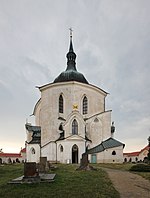
|
Vysočina Region | 1994 | 690; iv (cultural) | The Pilgrimage Church of St John of Nepomuk was built between 1719 and 1727, following the canonization of the eponymous saint. It was designed by Jan Santini Aichel and marks the architectural transition between the Gothic and Baroque traditions.[9][10] |
| Kutná Hora: Historical Town Centre with the Church of St Barbara and the Cathedral of Our Lady at Sedlec | 
|
Central Bohemian Region | 1995 | 732; ii, iv (cultural) | In the late 13th century, rich silver deposits were discovered in the area, which led to the development and prosperity of Kutná Hora. In the 14th century, it became a royal city. The historic town centre preserves the Medieval ground plan. The two important buildings in the city are the Church of St Barbara, in the Gothic style, decorated with frescos depicting the life in the mining town, and the Cathedral of Our Lady at Sedlec, a former Cistercian monastery church, that was renovated in the Baroque style in the 18th century.[11] |
| Lednice–Valtice Cultural Landscape | 
|
South Moravian Region | 1996 | 763; i, ii, iv (cultural) | The Lednice–Valtice estate is one of the largest artificial landscapes in Europe, covering 200平方キロメートル (77 sq mi). The Dukes of Liechtenstein, who owned the property, transformed it into a cultural landscape between the 17th and 20th centuries. They constructed several country houses, manors, churches, and other buildings in Baroque and Neoclassical styles, as well as a network of avenues, scenic trails, and forest paths. Gardens and parks were influenced by the English landscape gardens.[12] |
| Gardens and Castle at Kroměříž | 
|
Zlín Region | 1998 | 860; ii, iv (cultural) | The Castle in Kroměříž was constructed in the 17th and 18th centuries in the early Baroque style and served as the residence of the archbishop of Olomouc. The Pleasure Garden (pictured), laid out in 1665–1675, is a rare example of a Baroque garden that has remained relatively intact. It influenced the development of other gardens in central Europe. The Castle Garden features buildings in Neoclassical and French Empire styles.[13][14] |
| Holašovice Historical Village Reservation | 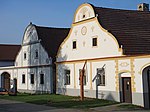
|
South Bohemian Region | 1998 | 861; ii, iv (cultural) | The village of Holašovice is a well-preserved example of a traditional village from central Europe. The village comprises farmsteads of different sizes from the 18th and 19th centuries that have facades with stucco decorations in a style that is known as South Bohemian Folk Baroque.[15] |
| Litomyšl Castle | 
|
Pardubice Region | 1999 | 901; ii, iv (cultural) | The Litomyšl Castle was constructed as a country residence in the second half of the 16th century, in the Renaissance style. It is a four-winged, three-storeyed building, with one of the wings consisting of a two-storeyed arcaded gallery. The facade is decorated in the sgraffito technique. The interior is decorated in the Baroque style. A range of ancillary buildings is also preserved.[16] |
| Holy Trinity Column in Olomouc | 
|
Olomouc Region | 2000 | 859rev; i, iv (cultural) | The Holy Trinity Column was erected in the historic centre of the town of Olomouc in the early 18th century, in the regional style, called the Olomouc Baroque. It is a plague column, the largest of its kind in Europe, with the height of 35メートル (115 ft). It was designed by Václav Render and many of its sculptures, representing religious themes, are the works of Ondřej Zahner. The monument includes a small chapel at the base of the column.[17][18] |
| Tugendhat Villa in Brno | 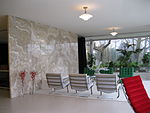
|
South Moravian Region | 2001 | 1052; ii, iv (cultural) | The Tugendhat Villa was designed by the German architect Ludwig Mies van der Rohe in the 1920s for Grete and Frits Tugendhat, members of a rich industrial family from Brno. The villa is an example of the International Style of architecture. Mies van der Rohe also designed the furniture and the adjacent garden.[19] |
| Jewish Quarter and St Procopius' Basilica in Třebíč | 
|
Vysočina Region | 2003 | 1078bis; ii, iii (cultural) | The town of Třebíč is located on the banks of the Jihlava river. St. Procopius Basilica was built in the early 13th century, originally as a part of a Benedictine monastery. The Jewish Quarter is a well-preserved example of a Jewish ghetto, dating to the Middle Ages. A typical building has a condominium structure, with workshops on the street level and the residential upper levels. The two phases of the Jewish cemetery date to the 15th and 19th centuries.[20] |
| Erzgebirge/Krušnohoří Mining Region | 
|
North Bohemia | 2019 | 1478; ii, iii, iv (cultural) | The Ore Mountains span over south-eastern Germany and north-western Czechia. The region has been an important source of metals since the 12th century, including silver (especially in the 15th and 16th centuries), tin, cobalt, and also uranium in the late 19th and 20th centuries. The cultural landscape of the region was shaped by mining and smelting innovations.[21] |
| Landscape for Breeding and Training of Ceremonial Carriage Horses at Kladruby nad Labem | 
|
Pardubice Region | 2019 | 1589; iv, v (cultural) | The stud farm at Kladruby nad Labem was founded in 1579. It is located on the floodplain of the Labe river in the remnants of a riparian forest. The farm breeds the horses of the Kladruber breed that were used during the ceremonies at the Habsburg Court.[22] |
Tentative list
[編集]In addition to sites inscribed on the World Heritage List, member states can maintain a list of tentative sites that they may consider for nomination. Nominations for the World Heritage List are only accepted if the site was previously listed on the tentative list.[23] 2021年現在[update], the Czech Republic recorded 17 sites on its tentative list. The sites, along with the year they were included on the tentative list are:[4]
| Site | Image | Location | Year listed | UNESCO criteria | Description |
|---|---|---|---|---|---|
| Renaissance Houses at Slavonice | 
|
South Bohemian Region | 2001 | i, ii, iv (cultural) | The town of Slavonice was founded at the crossing of important trade routes and rose to prominence when the post office was established there in 1530. It declined from the 18th century on which meant that the burgher houses in Late Gothic and Renaissance styles remained preserved. Several houses feature facade decorations in the sgraffito technique.[24] |
| Paper Mill at Velké Losiny | 
|
Olomouc Region | 2001 | ii, iv (cultural) | The paper mill at Velké Losiny was founded in 1591 and has been operational ever since. The present buildings mostly date to the first half of the 19th century when the mill underwent an extensive reconstruction. In the early 20th century, the water wheel was replaced with a Francis turbine and the mill also started providing electricity to the town. Since 1987 the mill has housed a papermaking museum.[25] |
| Fishpond Network in the Třeboň Basin | 
|
South Bohemian Region | 2001 | i, ii, iii, iv, v (cultural) | Fish farming in the area around the town of Třeboň developed in the Middle Ages, after the House of Rožmberk acquired it in 1366. Several fish ponds were constructed, together with the adjacent infrastructure, such as canals and sluice gates. The largest of the ponds is the Rožmberk Pond.[26] |
| Český ráj (Czech Paradise) Rock Cities | 
|
several locations | 2001 | (natural) | Český ráj consists of several sites with rock formations that were created by erosion processes from Cretaceous sandstones. Formations at Hrubá Skála are pictured.[27] |
| Sites of Great Moravia: Slavonic Fortified Settlement at Mikulčice – Church of St. Margaret at Kopčany* | 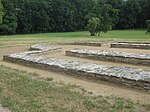
|
South Moravian Region | 2001 | iii, v (cultural) | Mikulčice was an important fortified settlement of the Slavonic state of Great Moravia in the Early Middle Ages. It was located in the area that now stretches across the borders of Slovakia and Czechia. Foundations of churches, burial sites, and remains of the fortifications have been uncovered at the site. The Church of St. Margaret on the Slovakian side dates to the 9th century and underwent renovations in the 13th and 16th centuries.[28][29] |
| The Industrial Complexes at Ostrava | 
|
Moravian-Silesian Region | 2001 | i, iv, v (cultural) | This nomination comprises sites of technical heritage related to the anthracite-based production of iron. The industrial complex in Vítkovice includes coal mines, coking plants, and blast furnaces, and has been for decades one of the most important centres of coal mining and heavy industry in Europe. Industrial activities started in the 1830s, restructuring took place in the 1910s, and the mining operations were terminated in 1993.[30] |
| The Fortress of Terezín | 
|
Ústí nad Labem Region | 2001 | i, ii, iv (cultural) | The Fortress of Terezin was constructed in the late 18th century, following the wars between Austria and Prussia. The fortification system consists of two bastion forts connected by entrenchments. During World War II, the Small Fortress served as a Gestapo prison and the Main Fortress as a Jewish Ghetto.[31] |
| The Spa at Luhačovice | 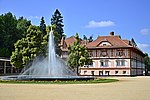
|
Zlín Region | 2001 | i, ii, iii, iv (cultural) | The first spa-related activities at Luhačovice began in the late 18th century and grew over the 19th century. In the first third of the 20th century, several new buildings were constructed following the plans of the architect Dušan Jurkovič, mixing the folk architectural styles with Art Nouveau. A Constructivist Community Centre was built in the 1930s.[32] |
| The Betlém Rock Sculptures near Kuks | 
|
Hradec Králové Region | 2001 | i, ii, iv (cultural) | This nomination covers the assembly of Baroque sculptures by Matthias Braun. They were commissioned by Franz Anton von Sporck, an art patron, in the early 18th century. The sculptures, named after Betlehem, are located around the hospital and spa complex near the village of Kuks. They are carved into the sandstone boulders and depict Biblical motives, such as the Nativity scene and the Adoration of the Magi. There are also several statues of saints.[33] |
| The Karlštejn Castle | 
|
Central Bohemian Region | 2001 | i, ii, iv (cultural) | The Karlštejn Castle was constructed in the mid-14th century for Charles IV, Holy Roman Emperor, at that time the King of Bohemia. The castle is built on a rocky ridge. The most prominent feature of the castle is the Great Tower that contains the Chapel of the Holy Cross. The chapel used to house the Imperial Regalia and the Bohemian Crown Jewels until 1420. The castle saw several renovations in the following centuries, with the Great Tower being restored to the Gothic look in the 19th century.[34] |
| Extension of the World Heritage Site "Historic Centre of Prague" with the important Monuments in its Vicinity | 
|
Prague | 2001 | i, ii, iv (cultural) | This nomination proposes the inclusion of three monuments, constructed in different periods, to the existing World Heritage Site: the Modernist Müller Villa, The Břevnov Abbey, founded in the 10th century, and the Renaissance Hvezda Hunting Lodge With lts Game-park (pictured).[35] |
| Mountain-top Hotel and Television Transmitter Ještěd | 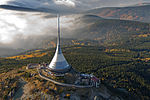
|
Liberec Region | 2007 | i, ii, iv (cultural) | The hyperboloid structure that comprises a hotel and a television transmitter was designed by the Czech architect Karel Hubáček. It is located on the mountain top of Ještěd, at an elevation of 1,012メートル (3,320 ft). It was constructed from 1966 to 1973 using steel and reinforced concrete.[36] |
| Žatec – the Hops Town | 
|
Ústí nad Labem Region | 2007 | ii, iii, iv (cultural) | Due to favourable weather conditions, the area around the town of Žatec has been used to cultivate hops since the Middle Ages. The hop industry expanded in the 19th century and brought prosperity to the town. Several related buildings date to this period, including the drying houses, packaging halls, and storage buildings, as well as residential houses.[37] |
| The West Bohemian Spa Triangle | 
|
Karlovy Vary Region | 2008 | ii, iii, iv (cultural) | The spa towns of Karlovy Vary, Mariánské Lázně (pictured), and Františkovy Lázně developed around thermal and mineral water sources that were used for medical treatments and leisure. They reached the peak between the 19th and early 20th century. See also the Great Spas of Europe nomination from 2014.[38] |
| Great Spas of Europe (Czechia)* | 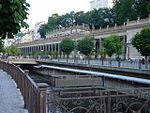
|
Karlovy Vary Region | 2014 | ii, iii, iv, vi (cultural) | This transnational nomination in seven countries comprises important European spa towns. They developed around sources of mineral and thermal water that was used for medical treatments and leisure. They reached the peak between the 18th century and the 1920s, before the development of industrialised medication. Three spas in Czechia are nominated, Karlovy Vary (pictured), Mariánské Lázně, and Františkovy Lázně.[39] |
| Ancient and Primeval Beech Forests of the Carpathians and Other Regions of Europe – extension (Czechia)* | 
|
Liberec Region | 2019 | (ix) natural | This is a proposed extension to the World Heritage Site already listed in 12 countries, comprising examples of temperate forests that demonstrate the postglacial expansion process of European beech from a few isolated refuge areas in the Alps, Carpathians, Dinarides, Mediterranean, and Pyrenees. The Jizera Mountains Beech Forest National Nature Reserve is nominated in Czechia.[40] |
| Old Wastewater Treatment Plant in Prague-Bubeneč | 
|
Prague | 2020 | ii, iv (cultural) | The sewage plant in Prague is an example of technical heritage from the turn of the 20th century. It was designed by the civil engineer William Heerlein Lindley as a part of the Prague’s modern sewerage system. It was constructed from 1901 to 1906 and became operational in the following year. It was operational until 1967, used for sludge management until the 1980s, and was later converted to a museum.[41] |
See also
[編集]References
[編集]- ^ “The World Heritage Convention”. UNESCO World Heritage Centre. 27 August 2016時点のオリジナルよりアーカイブ。7 July 2019閲覧。
- ^ “Convention Concerning the Protection of the World Cultural and Natural Heritage”. UNESCO World Heritage Centre. 1 February 2021時点のオリジナルよりアーカイブ。3 February 2021閲覧。
- ^ Report of the Rapporteur (Report). UNESCO World Heritage Centre. 14 December 1992. OCLC 955137903. 2016年4月1日時点のオリジナルよりアーカイブ。2014年7月22日閲覧。
- ^ a b “Czechia”. UNESCO World Heritage Centre. 26 January 2021時点のオリジナルよりアーカイブ。23 February 2021閲覧。
- ^ “UNESCO World Heritage Centre The Criteria for Selection”. UNESCO World Heritage Centre. 14 January 2021時点のオリジナルよりアーカイブ。17 August 2018閲覧。
- ^ “Historic Centre of Prague”. UNESCO World Heritage Centre. 26 October 2011時点のオリジナルよりアーカイブ。20 October 2011閲覧。
- ^ “Historic Centre of Český Krumlov”. UNESCO World Heritage Centre. 17 October 2011時点のオリジナルよりアーカイブ。20 October 2011閲覧。
- ^ “Historic Centre of Telč”. UNESCO World Heritage Centre. 17 October 2011時点のオリジナルよりアーカイブ。20 October 2011閲覧。
- ^ “Pilgrimage Church of St John of Nepomuk at Zelená Hora”. UNESCO World Heritage Centre. 17 October 2011時点のオリジナルよりアーカイブ。20 October 2011閲覧。
- ^ “Vysočina: kraj s nejvyšším počtem památek UNESCO” [Vysočina: region with the highest number of UNESCO monuments] (チェコ語). Právo. Novinky.cz (25 January 2007). 4 March 2016時点のオリジナルよりアーカイブ。22 April 2014閲覧。
- ^ “Kutná Hora: Historical Town Centre with the Church of St Barbara and the Cathedral of Our Lady at Sedlec”. UNESCO World Heritage Centre. 17 October 2011時点のオリジナルよりアーカイブ。20 October 2011閲覧。
- ^ “Lednice-Valtice Cultural Landscape”. UNESCO World Heritage Centre. 17 October 2011時点のオリジナルよりアーカイブ。20 October 2011閲覧。
- ^ “Gardens and Castle at Kroměříž”. UNESCO World Heritage Centre. 18 October 2011時点のオリジナルよりアーカイブ。20 October 2011閲覧。
- ^ “Archbishop's Chateau Kroměříž”. Archbishop’s Chateau Kroměříž. 26 February 2021時点のオリジナルよりアーカイブ。15 February 2021閲覧。
- ^ “Holašovice Historical Village Reservation”. UNESCO World Heritage Centre. 17 October 2011時点のオリジナルよりアーカイブ。20 October 2011閲覧。
- ^ “Litomyšl Castle”. UNESCO World Heritage Centre. 17 October 2011時点のオリジナルよりアーカイブ。20 October 2011閲覧。
- ^ “Holy Trinity Column in Olomouc”. UNESCO World Heritage Centre. 18 October 2011時点のオリジナルよりアーカイブ。20 October 2011閲覧。
- ^ “Holy Trinity Column in Olomouc, WHC Nomination Documentation”. UNESCO World Heritage Centre. p. 7. 5 July 2020時点のオリジナルよりアーカイブ。21 February 2021閲覧。
- ^ “Tugendhat Villa in Brno”. UNESCO World Heritage Centre. 18 October 2011時点のオリジナルよりアーカイブ。20 October 2011閲覧。
- ^ “Jewish Quarter and St Procopius' Basilica in Třebíč”. UNESCO World Heritage Centre. 17 October 2011時点のオリジナルよりアーカイブ。20 October 2011閲覧。
- ^ “Erzgebirge/Krušnohoří Mining Region”. UNESCO World Heritage Centre. 26 September 2020時点のオリジナルよりアーカイブ。8 July 2019閲覧。
- ^ “Landscape for Breeding and Training of Ceremonial Carriage Horses at Kladruby nad Labem”. UNESCO World Heritage Centre. 7 October 2020時点のオリジナルよりアーカイブ。27 August 2019閲覧。
- ^ “Tentative Lists”. UNESCO World Heritage Centre. September 24, 2005時点のオリジナルよりアーカイブ。July 12, 2014閲覧。
- ^ “Renaissance Houses at Slavonice”. UNESCO World Heritage Centre. 10 June 2007時点のオリジナルよりアーカイブ。19 January 2001閲覧。
- ^ “Paper Mill at Velké Losiny”. UNESCO World Heritage Centre. 10 June 2007時点のオリジナルよりアーカイブ。19 January 2001閲覧。
- ^ “Fishpond Network in the Trebon Basin”. UNESCO World Heritage Centre. 3 October 2015時点のオリジナルよりアーカイブ。19 January 2001閲覧。
- ^ “Český ráj (Czech Paradise) Rock Cities”. UNESCO World Heritage Centre. 10 June 2007時点のオリジナルよりアーカイブ。19 January 2001閲覧。
- ^ “Sites of Great Moravia: Slavonic Fortified Settlement at Mikulčice – Church of St. Margaret at Kopčany”. UNESCO World Heritage Centre. 10 February 2021時点のオリジナルよりアーカイブ。4 February 2021閲覧。
- ^ “Sites of Great Moravia: Slavonic Fortified Settlement at Mikulčice – Church of St. Margaret at Kopčany”. UNESCO World Heritage Centre. 10 February 2021時点のオリジナルよりアーカイブ。4 February 2021閲覧。
- ^ “The Industrial Complexes at Ostrava”. UNESCO World Heritage Centre. 7 July 2016時点のオリジナルよりアーカイブ。6 July 2001閲覧。
- ^ “The Fortress of Terezín”. UNESCO World Heritage Centre. 10 June 2007時点のオリジナルよりアーカイブ。6 July 2001閲覧。
- ^ “The Spa at Luhacovice”. UNESCO World Heritage Centre. 16 February 2007時点のオリジナルよりアーカイブ。6 July 2001閲覧。
- ^ “The Betlém Rock Sculptures near Kuks”. UNESCO World Heritage Centre. 28 August 2006時点のオリジナルよりアーカイブ。6 July 2001閲覧。
- ^ “The Karlstejn Castle”. UNESCO World Heritage Centre. 10 June 2007時点のオリジナルよりアーカイブ。6 July 2001閲覧。
- ^ “Extension of the World Heritage Site "Historic Centre of Prague" with the important Monuments in its Vicinity”. UNESCO World Heritage Centre. 10 June 2007時点のオリジナルよりアーカイブ。6 July 2001閲覧。
- ^ “Mountain-top Hotel and Television Transmitter Ještěd”. UNESCO World Heritage Centre. 13 October 2007時点のオリジナルよりアーカイブ。29 May 2007閲覧。
- ^ “Žatec – the Hops Town”. UNESCO World Heritage Centre. 13 October 2007時点のオリジナルよりアーカイブ。29 May 2007閲覧。
- ^ “The West Bohemian Spa Triangle”. UNESCO World Heritage Centre. 22 June 2011時点のオリジナルよりアーカイブ。25 June 2008閲覧。
- ^ “Great Spas of Europe (Czechia)”. UNESCO World Heritage Centre. 11 November 2014時点のオリジナルよりアーカイブ。17 June 2014閲覧。
- ^ “Ancient and Primeval Beech Forests of the Carpathians and Other Regions of Europe – extension (Czechia)”. UNESCO World Heritage Centre. 13 September 2019時点のオリジナルよりアーカイブ。30 January 2019閲覧。
- ^ “Old Wastewater Treatment Plant in Prague-Bubeneč”. UNESCO World Heritage Centre. 13 August 2020時点のオリジナルよりアーカイブ。28 February 2021閲覧。
External links
[編集]Template:Czech Republic topics Template:World Heritage Sites in the Czech Republic Template:Lists of World Heritage Sites in Europe

